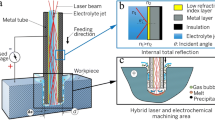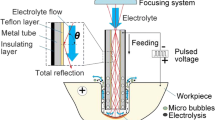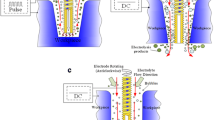Abstract
The coaxial laser has been introduced to shaped tube electrochemical machining (STEM), referred to as laser-STEM, to enhance the materials removal rate and precision. To address the issue of central residual formation during the laser-STEM process, which limited the machining stability and feeding rate, the retracted hybrid tubular electrode was applied. The formation mechanisms and effects of the W-shaped central residual were analyzed. Simulation and experiments were conducted to study the impact of the retracted length of the tubular electrode. Simulation results showed that a retracted length of 1–1.5 mm of the inner low-refractive layer could improve the electric current density distribution homogeneity to remove the W-shaped central residual in the machining area. The electric current density distribution homogeneity in the machining zone has been decreased by 38% by utilizing the hybrid tubular electrode with a retracted length of 2.0 mm. With a proper retracted length, the laser coupling efficiency exceeded 74.5%. Hence, the retracted hybrid tubular electrode could act as both the tool electrode and optical waveguide in the laser-STEM process. Experimental results proved that the machining efficiency and precision of laser-STEM could be enhanced by utilizing the retracted hybrid tubular electrode. With the retracted length deg rising from 0 to 1.5 mm, the maximum feeding speed increased by 373%, and the machining precision was improved by 42.2%. The maximum feeding rate of 4.1 mm/min has been achieved using the retracted hybrid tubular electrode in the laser-STEM process, which has been improved by 105%, compared with the available maximum feeding rate of the tubular electrode in the STEM process. Finally, the small holes with a diameter of 1.4 mm and an aspect ratio of 15 have been processed by laser-STEM with the retracted hybrid tubular electrode.















Similar content being viewed by others
Availability of data and material
The datasets used or analyzed during the current study are available from the corresponding author on reasonable request.
Code availability
Not applicable.
References
Li ZY, Wei XT, Sun JJ, Zang CW, Fu CH, Guo YB (2015) Process capability and effect size of vacuum extraction shaped tube electrolytic drilling of Inconel alloy for high-performance cooling hole. Int J Adv Manuf Technol 85:2557–2566
Kozak J, Rajurkar KP, Makkar Y (2004) Study of pulse electrochemical micromachining. J Manuf Process 1:7–14
Rajurkar KP, Zhu D, Mcgeough JA, Kozak J, Silva AD (1999) New developments in electro-chemical machining. CIRP Ann Manuf Technol 48:567–579
Bilgi DS, Jain VK, Shekhar R, Mehrotra S (2004) Electrochemical deep hole drilling in super alloy for turbine application. J Mater Process Technol 149:445–452
Yong L, Ruiqin H (2013) Micro electrochemical machining for tapered holes of fuel jet nozzles. Procedia CIRP 6:395–400
Datta M, Romankiw LT (1989) Application of chemical and electrochemical micromachining in the electronics industry. J Electrochem Soc 136:285C-292C
Park BJ, Kim BH, Chu CN (2006) The effects of tool electrode size on characteristics of micro electrochemical machining. CIRP Ann Manuf Technol 55:197–200
C. Jackson, R. D. Olson (1969) Shaped tube electrolytic machining (STEM drilling), SME Technique Paper 69–109
Sen M, Shan HS (2005) A review of electrochemical macro- to micro-hole drilling processes. Int J Mach Tools Manuf 45:137–152
McGeough JA (1974) Principles of electrochemical machining. Chapman and Hall
Rajurkar KP, Wei B, Kozak J, Mcgeough JA (1995) Modelling and monitoring interelectrode gap in pulse electrochemical machining. CIRP Ann Manuf Technol 44:177–180
Kozak J, Rajurkar KP, Makkar Y (2004) Selected problems of micro-electrochemical machining. J Mater Process Technol 149:426–431
Skoczypiec S (2011) Research on ultrasonically assisted electrochemical machining process. The International Journal of Advanced Manufacturing Technology 52:565–574
Wang XD, Qu NS, Fang XL, Li H (2016) Electrochemical drilling with constant electrolyte flow. J Mater Process Technol 238:1–7
M. Deepak, S.S. Joshi, S.K. Mitra (2008) Modeling of electrochemical micromachining: comparison to experiments, Journal of Micro/ Nanolithography, MEMS, and MOEMS 7:033015
Wang Y, Yang F, Zhang G, Zhang W (2019) Fabrication of deep and small holes by synchronized laser and shaped tube electrochemical machining (Laser-STEM) hybrid process. The International Journal of Advanced Manufacturing Technology 105:2721–2731
Tang L, Guo YF (2013) Experimental study of special purpose stainless steel on electrochemical machining of electrolyte composition. Mater Manuf Processes 28:457–462
Hewidy MS, Ebeid SJ, Rajurkar KP (2001) Electrochemical machining under orbital motion conditions. J Mater Process Technol 109:339–346
Zhang Y, Qu NS, Fang XL, Wang XD (2019) Eliminating spikes by optimizing machining parameters in electrochemical drilling. J Manuf Process 37:488–495
Zhang H, Xu J, Wang J (2009) Investigation of a novel hybrid process of laser drilling assisted with jet electrochemical machining. Opt Lasers Eng 47:1242–1249
Pajak PT, Desilva AKM, Harrison DK, Mcgeough JA (2006) Precision and efficiency of laser assisted jet electrochemical machining. Precis Eng 30:288–298
Wang YF, Zhang WW (2021) Theoretical and experimental study on hybrid laser and shaped tube electrochemical machining (Laser-STEM) process. The International Journal of Advanced Manufacturing Technology 112:1601–1615
Desilva AKM, Pajak PT, Harrison DK, Mcgeough JA (2004) Modelling and experimental investigation of laser assisted jet electrochemical machining. CIRP Ann 53:179–182
K.K. Saxena, J. Qian, D. Reynaerts (2020) A tool-based hybrid laser-electrochemical micromachining process: Experimental investigations and synergistic effects, International Journal of Machine Tools and Manufacture 155:103569
Zhu D, Xu HY (2002) Improvement of electrochemical machining accuracy by using dual pole tool. J Mater Process Technol 129:15–18
Fang XL, Qu NS, Zhang Y, Xu Z, Di Z (2014) Effects of pulsating electrolyte flow in electrochemical machining. J Mater Process Technol 214:36–43
Funding
This research was supported by the National Natural Science Foundation of China (51905525), the Natural Science Foundation of Zhejiang (LQ19E050003), the key research and development program of Zhejiang (2020C01036), and the Natural Science Foundation of Ningbo (2019A610152).
Author information
Authors and Affiliations
Contributions
Yufeng Wang contributed to the conception of the study, and guided experiments and conclusions; Yong Yang performed the experiment, analyzed the data, and completed the manuscript; Yujie Gui, Fuhui Shao, and Yulei Li assisted to experiment; Wenwu Zhang funded the study.
Corresponding author
Ethics declarations
Ethics approval
Not applicable.
Consent to participate
This study involved no ethical issues.
Consent for publication
This study involved no ethical issues.
Competing interests
The authors declare no competing interests.
Additional information
Publisher's note
Springer Nature remains neutral with regard to jurisdictional claims in published maps and institutional affiliations.
Rights and permissions
About this article
Cite this article
Yang, Y., Wang, Y., Gui, Y. et al. Improving performance of laser and shaped tube electrochemical machining by using retracted hybrid tubular tool electrode. Int J Adv Manuf Technol 118, 1779–1791 (2022). https://doi.org/10.1007/s00170-021-08097-w
Received:
Accepted:
Published:
Issue Date:
DOI: https://doi.org/10.1007/s00170-021-08097-w




